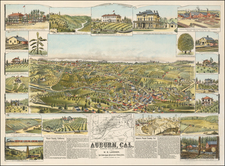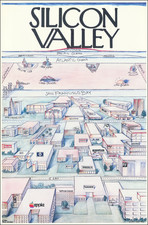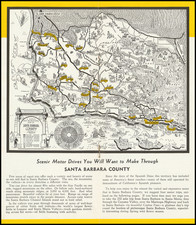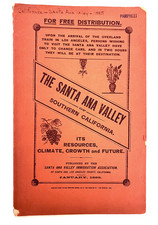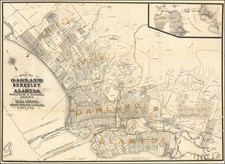"The Pasadena of Central California."
Rare 19th-century separately-issued promotional map for Thermalito, California,
Thermalito coalesced as a community between the late 1880s and 1895, when the post office was founded (it was discontinued in 1920). The present pamphlet suggests that citrus agriculture was a potential economic driver for the new town. But unlike most land promotions of the time, it's not immediately clear what else the area has to offer in the way of economic incentive. Today Thermalito and Oroville are associated with the adjacent large dams and hydroengineering complex.
The map-side consists of three images, one of Thermalito, one of South Thermalito, and one of Thermalito in the context of California as a whole. The map of Thermalito shows many of the outlying larger lots already sold, with the plots on residential blocks still wanting buyers. South Thermalito is completely unsold, and apparently would remain so; today it appears to be an uninhabited floodplain and parkland.
The name "Thermalito" suggests a diminutive derivation from Thermal, California, in the Coachella Valley, though the former predates the latter by two decades.
Today the city is functionally a residential neighborhood of Oroville.
Oroville Dam would not be finished until 1968, about 80 years after this map was made. The map reflects an interesting time period, well after the Gold Rush and its aftershocks had subsided, but before the 20th-century system of industrial agriculture and water management had set the agenda for economic development in the northern Central Valley.
Rarity
OCLC records only two examples, at the California State Library, and Cal State Chico.
The Schmidt Lithography Company was based in San Francisco. Max Schmidt, a German immigrant, founded his first printing business in 1873, and he was one of the first printers to use lithography on the West Coast. His plant burned twice, in 1884 and 1886, but by the 1890s he ran a factory in San Francisco, as well as branches in Portland and Seattle.
During the 1906 earthquake and fire the company’s premises were destroyed again. Schmidt quickly acquired a nearby paper factory and production continued practically uninterrupted. Within two years of the fire, Schmidt had rebuilt on the site of his former factory at the corner of Second and Bryant Streets.
Schmidt’s company was best known for its printed labels, but they also produced other items like separately-issued prints. The company was once the largest printing company on the West Coast and today they are remembered for the clock tower that still stands at Second and Bryant Streets.











![(California Pictorial Lettersheet) [Manuscript letter on Lettersheet with Bird's-eye view of Stockton, California]](https://storage.googleapis.com/raremaps/img/small/97542.jpg)
